This interview was first published on Writers Rebel.
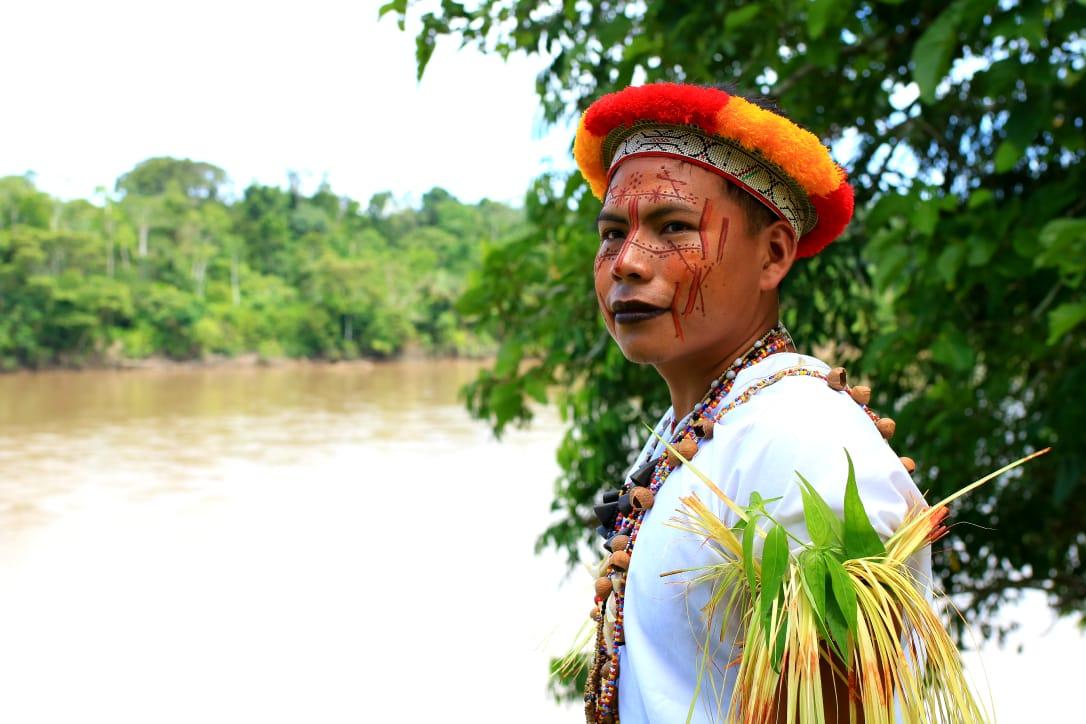
Jimmy Piaguaje in traditional dress. Photo: Ribaldo Piaguaje
Jimmy Piaguaje is a young indigenous Siekopai defender from Siekoya Remolino, a community of 53 families living on the banks of the Aguarico River in the northeastern Ecuadorian Amazon region.
The Siekopai (which means multicoloured people) are renowned for their shamanic acumen and knowledge of medicinal plants, with uses for over 1,000 different plants.
According to the Siekopai origin story, the god Ñañëpaina came down from the sky to find their people living underground and liberated them to live on the earth. Their language is called Paai koka. The Siekopai wear crowns and arm bands made of leaves and flowers and paint their bodies and faces with geometric designs. Also known as the Secoya, they are renowned for their excellent hot sauce, made from jungle peppers, and for drinking yoko (a coffee-like drink made from a vine).
The Siekopai are an endangered people defending a fragile ecosystem upon which we all depend: the Amazon rainforest.
Historically, the Siekopai numbered over 30,000 and had an immense territory that stretched an estimated 7 million acres from Ecuador into Colombia and Peru. Currently only around 1600 Siekopai remain, 900 in Peru and 700 in Ecuador, where they live in a 50,000-acre fragment of rainforest, surrounded by oil exploitation and oil palm monoculture plantations.
In response to the existential threats they face, Jimmy and a group of other young Siekopai leaders have developed a number of innovative projects, safeguarding ancestral shamanic knowledge in video format and running environmental workshops with Siekopai youth. Their next goal is to open an alternative school with an educational model based on their own cosmovision (click here to help them achieve this dream).
We spoke to Jimmy about the Siekopai’s resistance strategies and ancestral stories, about his shamanic journey, and how the indigenous worldview could help to combat climate change.
WR: How has the pandemic affected Siekopai communities?
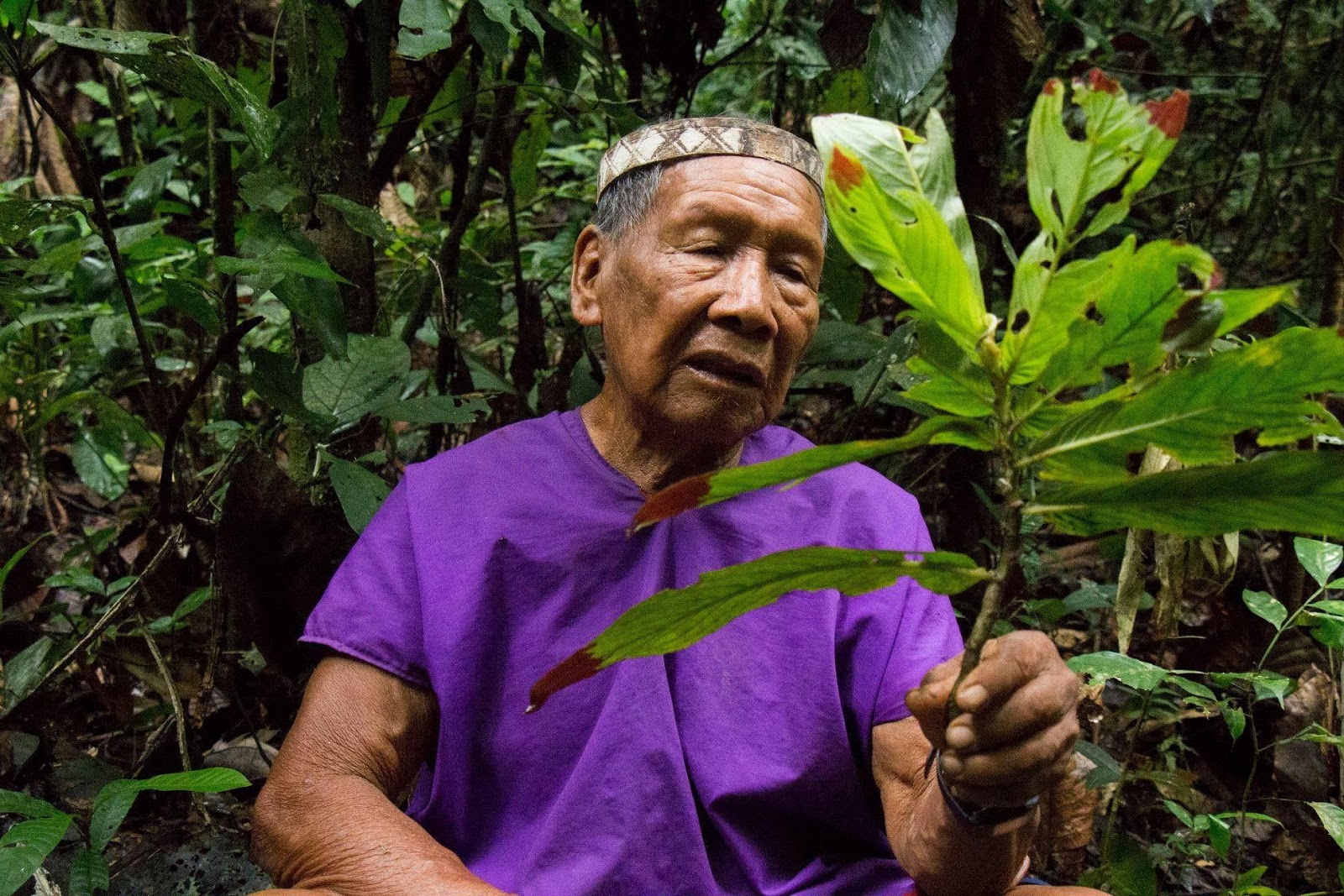
The Siekopai have been treating Covid-19 with medicinal plants. Photo: Siekopai archive.
JP: In the Ecuadorian Amazon, the Siekopai nationality was the first to confirm positive cases of Covid-19. A wise elder died of Covid, he was a family member of mine. He knew a lot about medicinal plants. That was major blow for the Siekopai because they aren’t many of us and we all know each other. Then a teacher died, he had long been involved in the struggle to defend our culture. It was a very difficult situation. We sought help from the local and national governments, but they didn’t really respond. Some allied organisations provided medicines, tests and accurate information. But we started to realise that the medicine from outside, it wasn’t helping us. Faced with many cases of Covid, we started to look to medicinal plants. In the end, the majority of people who survived were treated with medicinal plants. And we’re still treating people with plant infusions, such as ajo del monte, chinchona and cedros with good results.
This has led to some very important reflections within the Siekopai communities; a rediscovery, appreciation and faith in our own ancestral medicines. And when everything collapsed in the outside world, although we were affected, we were more or less ok. This has been a deep reflection for us. Seeing how the rest of the world is suffering and realising what is important. Now when so many people in the world are learning to grow food, we keep maintaining our ancestral chakras (traditional small-scale agricultural areas). Now more than ever, we know the importance of our chakras, of our ancestral knowledge, of our medicinal plants. That’s been a real silver lining of the pandemic.
On the other hand, our food security situation has become even more precarious, as people from outside our territory take advantage of the pandemic to invade for fishing and hunting. We have been receiving parcels of food aid, and we are very grateful, but these are a short-term solution that create dependency and bring plastic waste into our communities. Food sovereignty is a major problem for us that dates much further back than the pandemic, due to our shrinking territory and contaminated rivers.
And the oil companies never stop. Despite the risk of them bringing the virus into the communities, they don’t stop working.
WR: Tell us more about the threats to the Siekopai territory.

The Siekopai live on the banks of the Aguarico River. Photo: Siekopai archive.
JP: We know from documents written by the Jesuits in the 1600s, when the missionaries arrived in Siekopai territory, that there were around 30,000 to 40,000 Siekopai at that time, in the zone between Putumayo, the Aguarico River and Napo. The missionaries brought illnesses such as flu and measles, which extinguished 90% of our population. Whole peoples and clans disappeared. Very few survived, hiding in the depths of the jungle. Then the rubber tappers arrived and removed the Siekopai even from there. So that’s how we lost our territory. We used to have a large population and territory, whereas now we only have around 700 people in Ecuador, living in a very reduced area. We feel very threatened, very worried because our territory is very small and we are surrounded by oil exploitation and monoculture agriculture.
The construction of roads is another threat. The state electricity company wants to build an access road within our territory to reach oil wells deep in the jungle. In our Assembly, we voted not to let them build it, but they keep insisting. The roads are a serious threat, our elders are really worried. Many Siekopai don’t want the roads, but others do. There is a part of the community that isn’t really conscious of what our territory means, because of influence from the outside world. I’m not saying the outside world is bad, but we have to find a balance between the two worlds, to decide how we are going to live. But there are some people who don’t think about that. They don’t think about other people, about the elders. They just think about personal benefit.
People from outside our territory invade our land for logging and hunting. When there is no work, these people turn to fishing, hunting and felling trees to make money. Our territory is very small and new roads make it even easier to remove natural resources (woods, animals and birds) for sale. This affects our community life and the biodiversity of the area. People sell the wood for pennies to try and send their kids to university. Almost all of the good timber trees are gone. Felling trees makes a lot of noise, the animals flee as far into the jungle as they can.
The roads also enable alcohol and drugs to enter our communities. It’s really sad to see how many young Siekopai are trapped in alcoholism and drug addiction. Just when the pandemic started, in February, a young Siekopai who was lost in the world of drugs committed suicide, it was really sad, he was a friend of mine.
I know from talking with my father, with our elders, how our territory used to be. Now we have almost no resources, almost no fish, no animals to hunt. Our rivers are contaminated by toxic waste from the oil palm industry. Lack of food sovereignty is a really big worry. These are the threats that we are facing.
All of these things have made us think about where we are going. Will our culture survive another five, ten, twenty years? Or will we just die?
WR: What are your main strategies of resistance?
JP: More and more people in the community are starting to realise that our territory really matters. So we started to monitor the territory, to patrol it, so that people can’t enter and hunt animals. Some families have started to plant various species of timber, edible and medicinal plants in their chakras. They are really happy with this work.
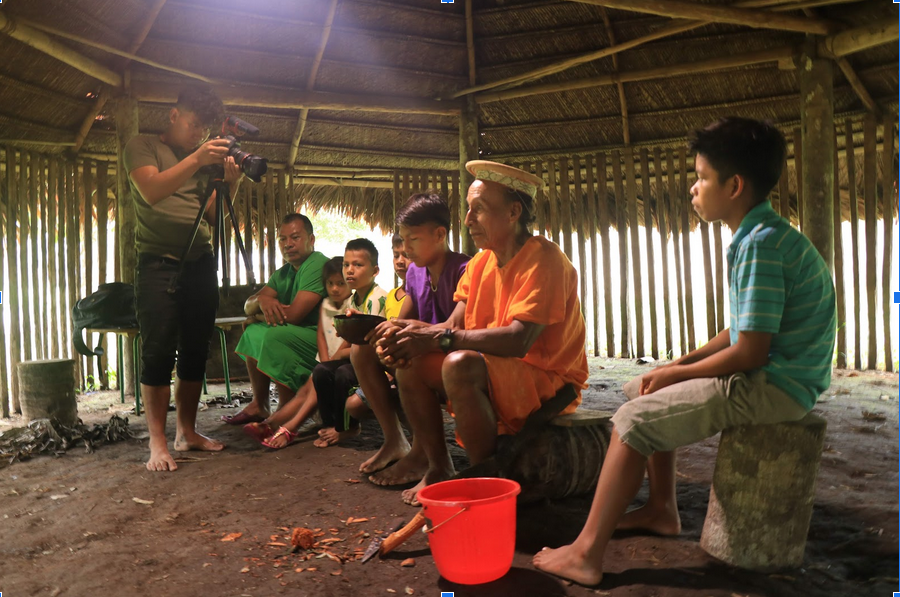
Intergenerational workshop. Photo: Siekopai archive.
I am part of a group of young Siekopai leaders who have formed an organisation, “Sëra”, which is the spirit of heaven that arrives every Kakotëkawë (summer) to announce a new era. Our first project was to begin safeguarding ancestral shamanic knowledge in video format.
Then we started working in the area of education, which has become our primary focus. We run school workshops to promote environmental awareness through intergenerational exchange between the elders, parents and children. We talk about ancestral knowledge, the identification and uses of medicinal plants, the threats that we face. We ask, what is important to us, what do we want to preserve, as Siekopai? The aim is to instil in the children the consciousness that our territory matters, that they should have respect for the elders, for Mother Nature, for our own cosmovision. We know that the children are like seeds; if we plant in them the idea that they must cut down the jungle to plant oil palm, they will want to do that. But instead we are saying to them, we must take care of the jungle, this is our wealth, there are other ways to do things, to survive. That’s why I think education is so important.
To address the problem of food sovereignty, we are working on a pisciculture (small-scale sustainable fish farming) project. If our people see that we have real alternatives like this, it would help us to resist the incursion of roads in our territory.
WR: What gives you hope and strength to continue fighting, after the Siekopai have suffered so much injustice?
JP: Being indigenous means resistance, struggle. My people have been resisting for over 400 years. Even though we have suffered much injustice, displacement, slavery, marginalisation, we have never lost our roots. We have never stopped fighting for freedom, for dignity and, most importantly, for our territories. We keep going with the same strength, with the same wisdom. We keep demanding the right to live once again in the territory of our ancestors, so that we can reconnect with the Great Spirit.
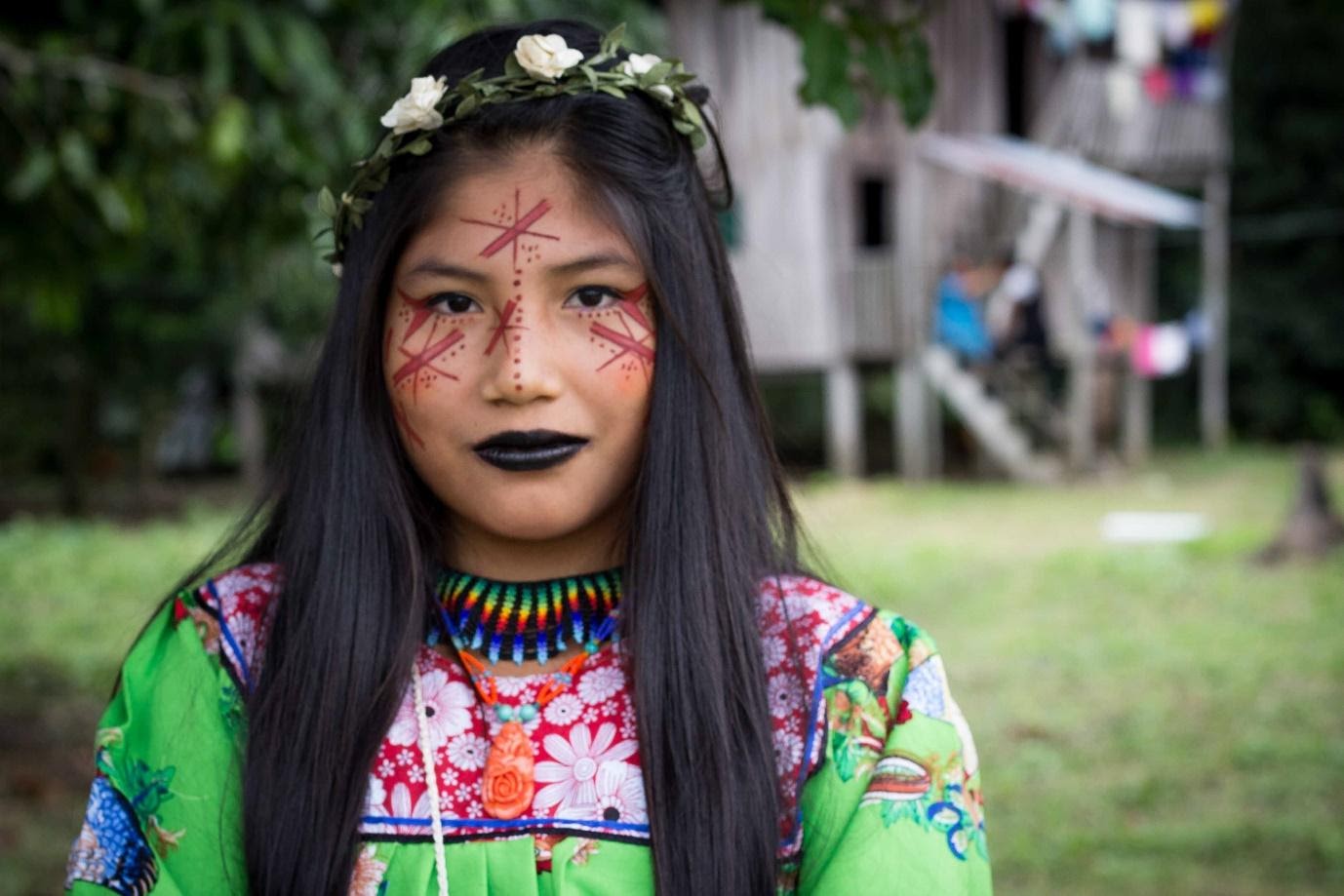
“Being indigenous means resistance.” Photo: Erin Deo.
My people give me a lot of hope. Even though there is much internal conflict and we have lost 90% of our territory and population, we have never given up. We keep on walking with faith, with our ancestors, who instilled in us the value of life, the value of respect, the value of resistance and the struggle. It also gives me a lot of hope to see young people from other indigenous nationalities and other territories joining their voices with the resistance, doing creative things, working with videos, rescuing our cultural values. I feel that I am not alone. There are lots of people like me, fighting for their territories. We can unite our voices to demand justice, to demand that indigenous territories are autonomous, that we can decide for ourselves what happens in our territories. And that is what gives me a lot of hope.
Also, people like you give me hope, we need people like you, who know the outside world, so that our voices can reach more people. So I am really happy to share with you, what we feel, what is happening to us, what we need to keep surviving, as Siekopai, as indigenous people.
Sometimes people use racial slurs against indigenous people. This has happened to me, but it’s never made me feel bad. I feel proud to call myself Siekopai, to call myself indigenous.
WR: How could the indigenous worldview help to combat climate change?
JP: This question really got me thinking. The indigenous worldview is based on living in harmony with nature and other people, respecting everything around us. It is a model that does not require us to plunder all natural resources. We are taught that we are all part of Mother Nature, that it is our responsibility to use resources in a sustainable way. Mother Nature provides everything: medicine, food, water, and air. We don’t need to destroy but to co-exist.
This way of life is based on reciprocity. Even if the other person is different to me, we share. Sharing and cooperation. That is how our ancestors lived and that should be the model of how we live too. I think a global shift towards these values could help to combat climate change.
A shift towards traditional indigenous agriculture could also help. There is a way of planting, with a prayer to Mother Nature, singing, so that the cassava and plantain grows well. We don’t need to clear a thousand hectares for monoculture plantations. Instead, we plant a diversity of trees, fruit trees, edible plants, and we share what we have.

Siekopai community life. Photo: Erin Deo.
Traditionally, the Siekopai lived communally in gigantic malokas (open sided wooden huts) with forty to sixty families. This coexistence meant that people did everything together. Everyone got up early around 3am to prepare and drink yoko, twist threads of chambira (a palm from which the fibre is removed to make hammocks) and tell stories and legends. The women would discuss what they would do that day, what the future would bring. The children would be there too, this is how they learned. For us, the maloka is a symbol of living in harmony, communal life, sharing. If one man went hunting, all the men would go hunting together, then they would share the food between everyone. It’s mutual effort, circular effort, in which no-one lacks anything and everyone has the same as everyone else.
WR: How have the ancestral stories of the Siekopai passed from generation to generation? Is there a story that is most iconic for the Siekopai?
JP: All knowledge, history and legends have been passed down orally, from parents to children, up until today, through daily practices such as hunting, fishing, and building malokas. In our oral traditions, there are many important stories, about plants, animals, spirits. For example, what to do if you’re walking in the jungle and an unknown spirit confronts you and frightens you, so that you don’t get sick.
There is one important and relevant story that I’d like to share. One day, some people from the village walked for half a day to go fishing in a river with barbasco (a plant substance used to stun fish so that they can be caught easily). When they arrived at the river, they started making their camp. One man left the group and went to find Juri, the spirit of the wind, who lived in a gigantic tree. The man asked Juri for permission to fish, as she was the owner of the river. She denied his request, saying that it was not the time for fishing, that they would have to wait. The man returned to the group and relayed what Juri had said, that they mustn’t fish, but his companions became angry and didn’t listen to him. They had walked a long way and were hungry, they wanted to eat. The man went once more to speak to Juri, who insisted that he stop his friends from fishing. But when he got back to the river, they had already caught and killed a lot of fish, they were smoking them over a fire and eating happily. In trepidation, the man went to tell Juri what had happened. The spirit of the wind became furious. She told the man to hide in a cave with his family. He ran to get his family, leaving his companions eating fish. On the way, he gathered some orchids, which he used to block the entrance to the cave. The orchids turned into dogs and guarded the family. Suddenly, the sky darkened and there was such a strong wind that tree branches were falling. The family could hear cries of desperation from the camp by the river, for Juri had removed the eyes of all the people who had been fishing, so that they could not return home. The animals of the jungle came, the jaguars, wild boars and ants, and devoured the people at the camp. Only the family in the cave survived.

The spirit of the wind lived in a gigantic tree. Photo: Mitch Anderson, Amazon Frontlines.
The reflection is that if we keep destroying the natural environment, the same thing will soon happen to us, that we will be become blind in the face of so much devastation and Mother Nature could finish us. This story seems very relevant to what is happening today, with the pandemic. The elders told these stories so that we would respect Mother Nature, live in harmony and learn that we don’t have to take all the natural resources, only what we need.
WR: What do the spirits of the jungle look like? Have you seen them?
JP: It is rare to see the spirits of the jungle, but I have felt them when I’ve been hunting. They live in gigantic ceibo trees in the very deep jungle where no one goes. Those who have seen them, people who go fishing at night, say that they are in the form of humans, about 1.5 metres tall with the nose, eyes and talons of an eagle. They have legs like humans but are covered in black feathers. All the people who have seen them, describe them like that. And when the spirits fly, they always use the wind, strong winds to soar. When there is any kind of exploitation in the jungle, these spirits lose their homes and they leave.
WR: The Siekopai nationality is known for its powerful shamans and knowledge of medicinal plants, especially yajé (ayahuasca). Tell us more about this, about your own journey with yajé, and about your project to save this ancient wisdom through videos.
JP: My people were always very spiritual, with many drinkers of yajé, many wise elders with a deep connection with the natural spaces, with the times, with animals. We knew yajé well, the spiritual world. When the missionaries arrived in the 60s and 70s, the majority of this knowledge was lost. The missionaries were working with the oil companies, they came to clear the jungle of indigenous peoples and let the oil companies work. The evangelicals prohibited the drinking of yajé, they said it belonged to the devil, and that those who drank it would go to hell. Those fears took hold of the elders.
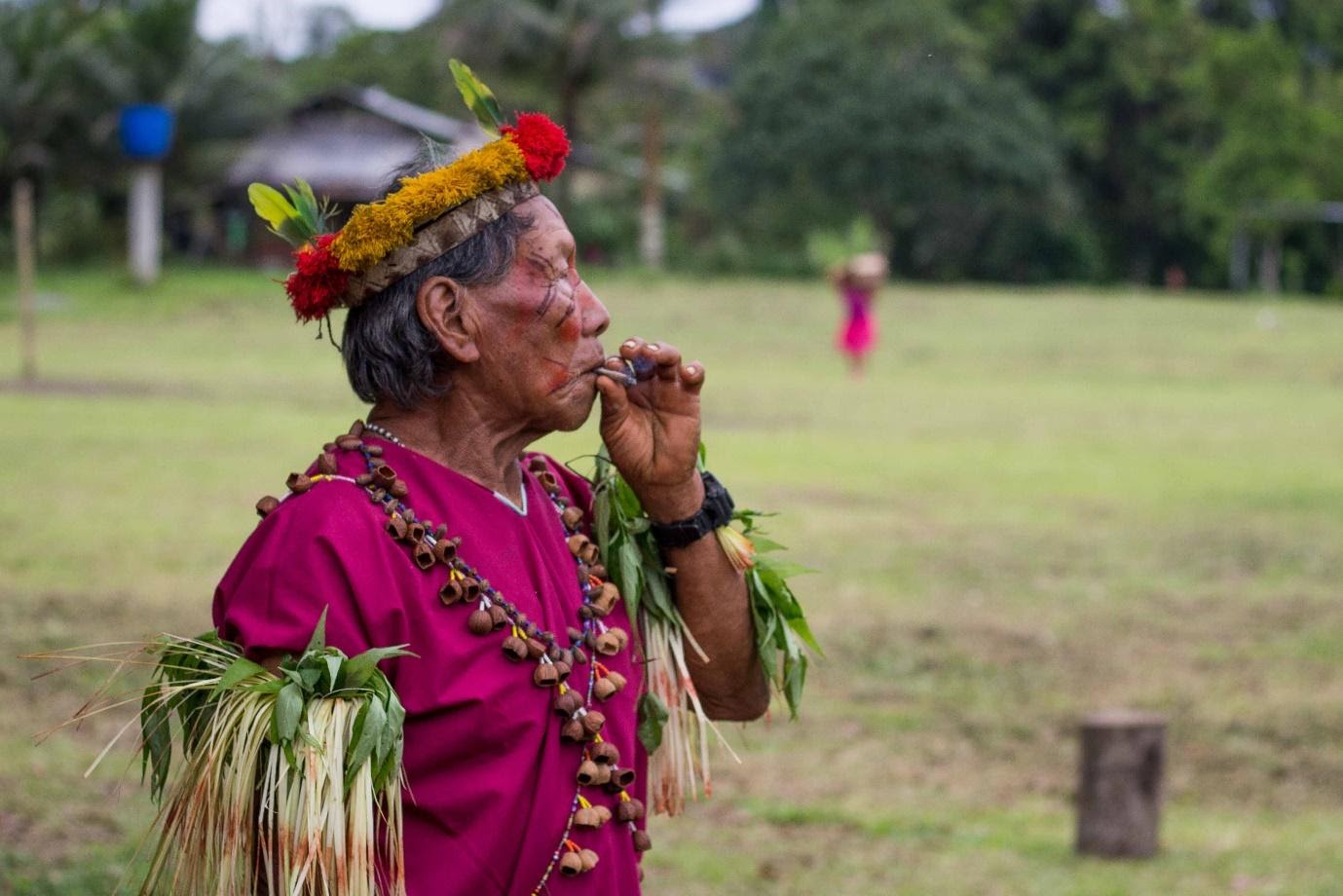
Siekopai elder. Photo: Erin Deo.
So many families stopped drinking yajé. My father stopped drinking it, but he still has a lot of knowledge about plants. Very few people still drink yajé, though my grandfather, Bacilio, still does. I have drunk several times with my grandfather.
I am on the path of plants, of yajé, of ancestral wisdom. I would like to follow this path further, to learn how to heal. Our elders have this knowledge, how to heal with tobacco smoke, with prayer, how to heal any illness. I have seen many people who are suffering, not just physically but in their souls. I would love to learn how to guide them in the path of life. I would love to be an example on the path of life, of the struggle, of resistance. The struggle has to be undertaken with good actions, not with cheating and lies, but from the heart, always connected with the universe, with the Great Spirit, always with this wisdom. This is my path, my objective that I am pursuing, learning from my father, from our elders.
I embarked on this path one day when I returned home from the city and found my mother very sick. In my desperation, I decided to drink yajé, in order to be closer to her if she died. In my yajé visions that night, I was walking and walking in the darkness and I couldn’t find the light. I was shouting and crying, I felt like my heart was broken, empty. I felt terrible pain in my soul, the worst pain I have ever felt in my life. It’s not possible to explain it. Eventually, after I had walked and shouted for so long in the darkness, a light appeared next to me and said “I am your god.” I was deeply confused. I thought, why is god here in my yajé vision, when he should be over there in the church? I couldn’t see the entity’s body, but it was wearing a white shining suit. And it said to me, “don’t worry, your mother won’t die, she will be well tomorrow. Keep following this path, I will keep lighting the way for you so that you can do things well.” I left the ceremony at 5am and went back home and my mum was fine, she was working in the chakra. I couldn’t believe it. And that changed my whole perspective on religion, on yajé. I understood that the true god is within all of us, in our positive actions, when we help each other, when we collaborate. God isn’t found in the church, but with each of us. That is what I learned through yajé.
There are very few young Siekopai following this path. I know a few, but they are not very committed. When I invite them to ceremony, they go with me. I always invite my nephews, I say to them, come and drink yajé rather than being drunk on beer, come and clean your soul, your spirit, your body. They always thank me afterwards.
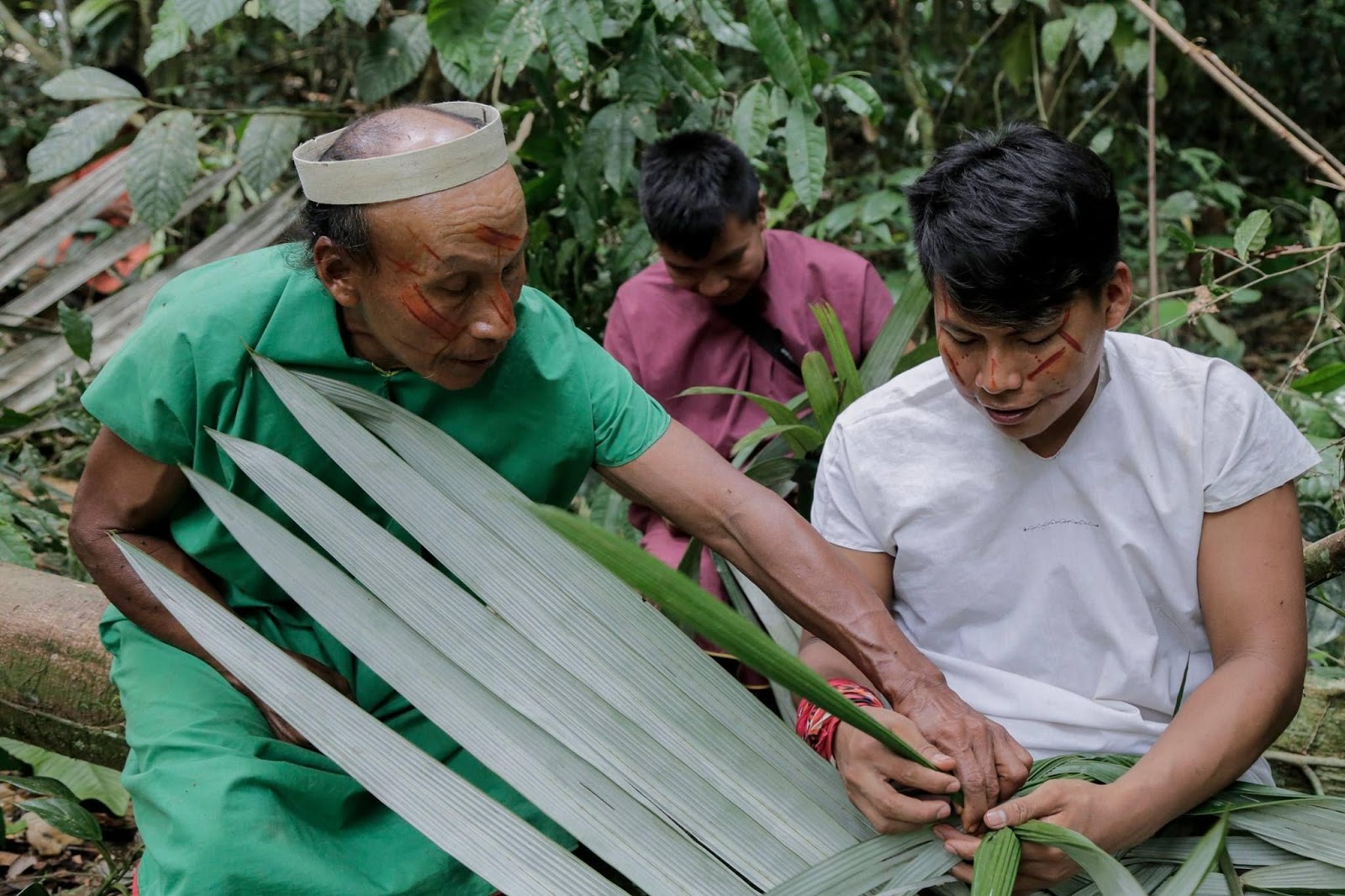
Jimmy and Ribaldo Piaguaje learning about plants from an elder. Photo: Jerónimo Zúñiga, Amazon Frontlines.
At the present time, ancestral knowledge is being rapidly lost. Young people are no longer interested, due to the influence of the western world. Our wise elders are dying without leaving a legacy. Together with another young Siekopai defender, I created a project to safeguard their knowledge with videos. We go out with them when they are harvesting plants and record them talking about how they identify and use them. (To learn more about this project and see some of the videos, click here). This project brought our group of young leaders together and we started to organise.
In August, my community held an important ceremony of yajé. The month of August (which is known as Kakotëkawë in our language) is very important to us, it’s the month of spirituality. According to our cosmovision, the celestial beings arrive in the treetops in the month of August. So, when one takes yajé, it is possible to connect with them more easily, with the Great Spirit. This is when we reflect on things that we need to improve, we plant and repair our chakras. In the month of August, our emotions are much stronger, we are very sensitive, we have to take great care of how we treat others, to be especially kind.
WR: Tell us about Lagartococha, the spiritual centre of the Siekopai, and the struggle to reclaim it.
JP: Pë’këya (Lagartococha) is the spiritual centre of the Siekopai. In the time before the arrival of the white men, the great Siekopai shamans from all corners of our territory gathered at the lagoons in Kakotëkawë (August) to perform yajé ceremonies, accompanied by the Kofanes and other indigenous peoples. In their visions, they connected with the Great Spirit, so that their peoples would never lack food, animals or fish, and would not be afflicted by disease. The shamans also looked into the future and let the people know that there was hope; that it was time to prepare their chakras and live well.
Today we follow the same path, every August we travel to Pë’këya to perform a ceremony, but there is no tranquility there now. Our ancestral territory has been lost to us and the struggle to reclaim it isn’t recent, it’s an old struggle, of our elders.
Our ancestors in that area suffered a lot, they were displaced by the rubber tappers and enslaved. Then, in the 1940s, Pë’këya was ravaged by the war between Ecuador and Peru. Our people there had to abandon their territory, to escape. When the area was divided by the militarisation of the border, some Siekopai communities and families did not see each other for half a century, until the signing of the 1998 peace treaty allowed reunification.
Following the war, the Ecuadorian State declared the area a reserve. Without acknowledging that the land is our ancestral territory, without recognizing that the Siekopai have always been present there, the State signed the land over to the Kichwas of Zancudo. To the State, jungle is jungle, they didn’t even ask who it belonged to. We don’t have a problem with the Kichwas, our complaint is directed at the State for violating our ancestral rights. We have asked for adjudication but we remain unanswered.
Our hopes of surviving as Siekopai rest on returning to Pë’këya, to our territory of origin, to reconnect with the spirits so that the shamans can pass their knowledge to the young. With the mandate of the elders, we built a ceremonial house there by a lagoon and planted yajé, in order to maintain the spiritual connection that allows us to live well. But the ceremonial house was burned by the Kichwas of Zancudo. We are really sad about this. We are people of peace, we do not want more war.
WR: How does the dominant economic model impact the destruction of the Amazon?
JP: The economic issue is one of the main drivers of destruction in the Amazon. The manufactured need for money is why there is so much deforestation and the animals are becoming extinct.
And yet, Amazonian communities need money like everyone one else. Those who say that money doesn’t exist in the indigenous world, don’t live in reality. Indigenous peoples need money because this need has been created in our communities by the outside world.
So what should we do about this? I have seen many examples of circular economies, cooperatives with horizontal structures. In these kind of community banks, no-one has privilege over anyone else, everyone in the organisation has a voice and a vote. The profits go to everyone, not just a powerful few. And that is how the money system should work in indigenous communities. There are lots of people who are experts on this topic. There should be training courses on this, so we can learn how this model works.
One of the main reasons that indigenous people need money is to educate their children. Going to university is very expensive for indigenous peoples. The need for this type of education, which was also introduced by the outside world, is a big driver for deforestation and must be resolved urgently.
I have seen that some Siekopai who study outside go on to exploit the natural resources of indigenous communities, using their university education as justification. So the higher education system is a double threat: people cut down trees so their children can be educated in a system of thought that itself leads to more destruction.
If we keep going with the same monopolised education model, that we can see isn’t working, that doesn’t meet our needs, that doesn’t create consciousness in young people, the same things will keep happening. More pandemics, floods, earthquakes. These are the reactions of Mother Nature, telling us that something is wrong.
WR: Why is the subject of education so important to you?
JP: Education is the fundamental pillar of society. The system of thought implemented in the curriculum generates the interaction between people and their ecosystems. There are many educational pedagogies that represent different ways of thinking, but the current education system is monopolized. This reduces the diversity of possibilities to create a better world for humanity and the planet. The current model only prepares us to work in a company, it doesn’t teach us how to coexist.
Society has to ask what is the objective of education. The reality of a society is a reflection of its education system. The current world situation shows us that monopolized education is not working. We can see this in climate change, in all the conflicts that are happening, in extractivism.
Educational pedagogies exist that are based on an objective of creating harmony between people and the environment. Although these are in the minority, they could be effective in these times of crisis to redirect the way in which we live.
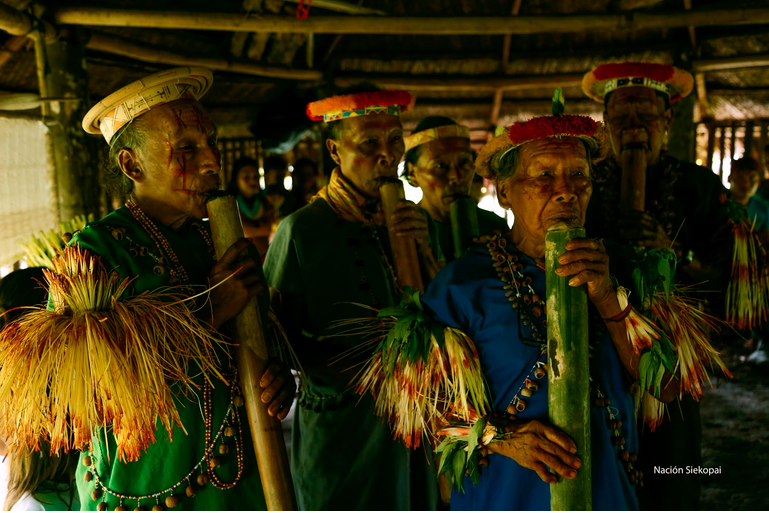
“The territories of ancestral peoples are rich in understanding that is unknown to the Western world.” Photo: Siekopai archives.
Indigenous peoples have had their own educational pedagogy for thousands of years that has allowed their communities and the natural environment to prosper, cycle after cycle. The territories of ancestral peoples are rich in understanding that is unknown to the western world. Sadly, the last generation to hold this knowledge is dying faster than ever, without transmitting it to the young people who are being educated in cities.
We have been working to preserve this knowledge through environmental workshops, which have been so successful that our next goal is to expand these into an alternative school. We have designed an educational model based on our own cosmovision, which allowed us to thrive in harmony with the natural environment for millennia. Our curriculum will blend this ancestral wisdom with aspects of modern knowledge to incorporate subjects such as permaculture, audio visual techniques and communications technology. The aim is to train conscious people capable of creating innovative, sustainable solutions. We hope to instil a value for life, a value that teaches people to be different, to think, and to do what they really love.
WR: How can the international community support your efforts?
JP: There are two ways in which people can help us.
In order to open our alternative school, we need to legalise our organisation, Sëra, as an NGO. We have been working on this process since 2018, but our efforts have been stalled by bureaucracy and lack of resources. We have put together a crowdfunding campaign to raise money for this and would be very grateful for any contributions. Sharing the campaign would also be a great help.
We also ask people to follow us on social media (Twitter @NSiekopai, Facebook @Siekopai) and Instagram @Nacion.Siekopai) and keep an eye out for our forthcoming Twitter storm to pressure the Ecuadorian State to formally adjudicate the case of our ancestral territory in Lagartococha.
Deoji! (Thank you!)

Siekopai children. Photos: Erin Deo
Jimmy Piaguaje was interviewed by Beth Pitts, who has been working with indigenous communities in Ecuador since 2013, especially those defending their territories from extractivism. From these defenders, Beth learned that community-led eco-tourism enables them to protect threatened ecosystems and unique ways of life. This inspired her to write the Moon Guide to Ecuador & The Galapagos Islands (2019), the first international guidebook on Ecuador with a focus on ethical travel.
Beth is part of the Writers Rebel team and is excited by the alchemic possibilities of uniting the two forces that give her the most hope for the future: indigenous nature defenders and Extinction Rebellion.